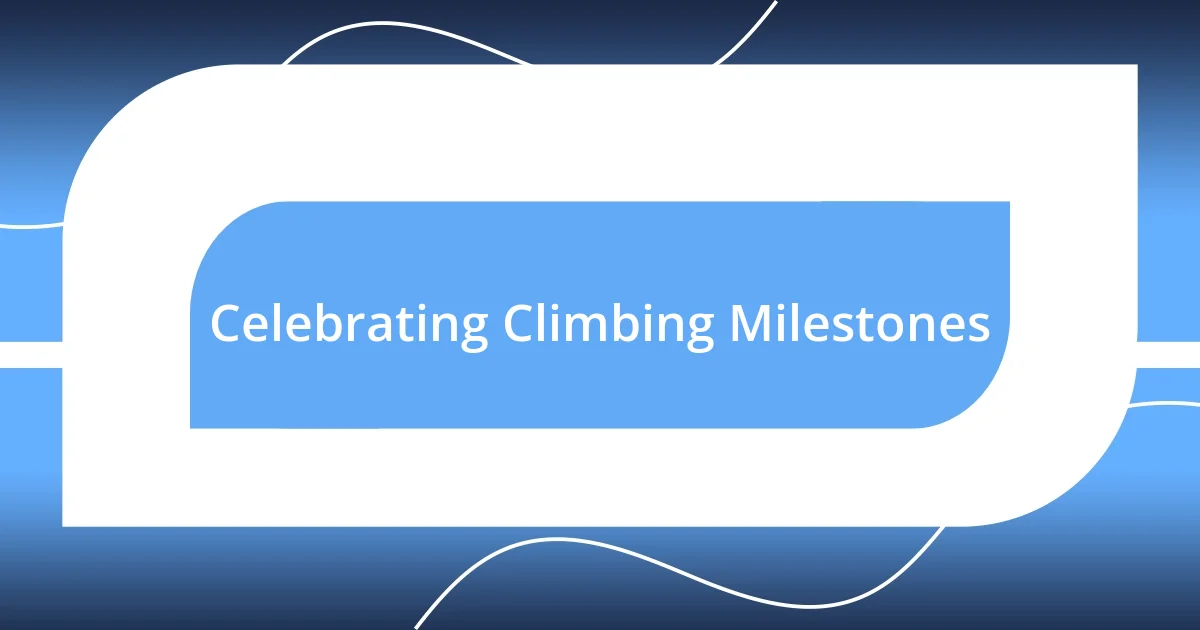Key takeaways:
- Understanding and acknowledging personal fears, such as fear of failure and height, can lead to personal growth and overcoming anxiety in climbing.
- Setting achievable goals, celebrating milestones, and engaging in positive mental preparation techniques, like visualization and mantras, significantly improve confidence and performance.
- Incorporating physical training and relaxation techniques, such as deep breathing and mindfulness, enhances both mental resilience and technical climbing skills.

Understanding Fear of Climbing
Fear of climbing often stems from a deep-rooted instinct for self-preservation. I remember my first outdoor climbing experience vividly; the height made my heart race, and I questioned my sanity for even attempting it. What if I fell? That fear was completely understandable, but learning about the safety systems in place helped me process those anxieties.
As I climbed higher, I realized that my fear was also psychological, linked to a fear of failure or embarrassment. The first time I slipped, my stomach dropped, and I felt exposed in front of my climbing partners. But I learned that everyone falls; it’s part of the journey. Isn’t it interesting how our fears can often transform into the very things we grow from?
Diving deeper into my climbing practice revealed that fear is just a state of mind. By acknowledging it, rather than denying it, I found ways to embrace those feelings instead of letting them dominate me. I often ask myself during a climb, “What’s the worst that could happen?” This question shifted my perspective, as I realized the potential for personal growth far outweighed the risk.

Recognizing Personal Triggers
Recognizing personal triggers is essential in understanding and overcoming my fear of climbing. I noticed that certain situations intensified my anxiety, like steep overhangs or unfamiliar routes. Reflecting on these moments helped me pinpoint not just my physical triggers but also emotional ones. For instance, if I was feeling particularly stressed from work or personal life, that anxiety would magnify my fear while climbing.
Here are some factors I identified that spurred my fear:
- Heightened Stress Levels: External stressors made me more susceptible to fear.
- Unfamiliarity: New routes or environments often felt more daunting.
- Peer Comparison: Feeling pressure to keep up with more experienced climbers increased my anxiety.
- Previous Falls: Past experiences of slipping added to my hesitation.
- Mental Fatigue: After a long day, my confidence dipped, making each move feel riskier.
By recognizing these triggers, I could better prepare myself mentally and emotionally before each climb.

Preparing Mentally for Climbing
Preparing mentally for climbing is a vital step that I didn’t take seriously at first. I’ll never forget the first time I stood at the base of a challenging crag, heart pounding. It felt overwhelming, but I started to develop a mindset that transformed that fear into fuel. I began crafting a mental checklist before every ascent, reminding myself to focus on my breathing and visualize each move. This little ritual turned each climbing session into a methodical practice rather than a chaotic scramble.
I often found that talking through my worries with a climbing partner helped me immensely. Sharing my thoughts created a bond that quieted my worries. For example, before every climb, I’d share my fears about any specific sections that seemed daunting, whether it was a tricky overhang or a high section. In return, my partner would reassure me, and that sense of camaraderie eased my mind. The connection we shared allowed me to transform what once felt like isolating fears into a collaborative effort, where I felt supported and understood.
Establishing a positive mantra was another game changer in my mental preparation. I created short phrases to repeat to myself, such as “I am confident,” or “I can handle this.” When doubt crept in, I’d say those affirmations aloud or silently in my head, grounding me in the moment. There’s something powerful about declaring positivity instead of dwelling on fear. It’s almost like a mental armor that equipped me for the climb ahead.
| Mental Preparation Technique | Personal Insight |
|---|---|
| Visualizing Moves | This technique helped me transform anxiety into focus, allowing me to anticipate the climb with clarity. |
| Sharing Fears | Engaging with a climbing partner and discussing my fears fostered a sense of community and support. |
| Using Positive Mantras | Having affirmations kept negative self-talk at bay and instilled a sense of confidence in each climb. |

Building Physical Strength and Skills
Building physical strength for climbing became a crucial part of my journey to conquer my fear. I remember starting with simple exercises at home, like pull-ups and core workouts. It was fascinating how each increment in strength boosted my confidence, allowing me to take on tougher routes. I often wondered: how could something as simple as a few push-ups transform my perception of fear? Each time I felt my body getting stronger, the daunting heights felt just a little less intimidating.
As I progressed, I began to incorporate climbing-specific training routines into my weekly schedule. I found that bouldering sessions not only improved my grip strength but also enhanced my problem-solving skills on the wall. The first time I reached the top of a boulder problem after struggling for a while, I felt a tide of accomplishment wash over me. That moment sparked a realization: strength isn’t just about muscles; it’s about building resilience and discovering that I can overcome obstacles, both physical and mental.
Moreover, I understood the importance of honing my technical skills. Learning how to properly place my feet and shift my weight made all the difference. I recall my instructor coaching me on foot placements during a climb; it was like a light bulb moment. Every correct placement made me feel more in control, regardless of the height I was at. Isn’t it amazing how mastering techniques can shift your mindset? Instead of just facing a rock face, I was engaging with it, and that engagement allowed me to embrace climbing rather than fear it.

Setting Achievable Climbing Goals
Setting achievable climbing goals is crucial for anyone looking to overcome their fears. I remember when I set my first goal: to climb a specific route that seemed impossible at the time. It felt daunting, but breaking it down into smaller milestones made it do-able. Each time I nailed a partial route or improved my technique, I felt a rush of accomplishment—a reminder that progress is built one step at a time.
I often reflect on how setting goals also created a roadmap for my climbing journey. Instead of simply aiming to reach the top, I focused on mastering one climbing technique each week. For instance, I dedicated a week to improving my footwork, and by the end, I could feel the difference in my control. This focus not only alleviated my fear but turned climbing into a game of skill and strategy, where I eagerly anticipated each improvement.
Moreover, I learned that celebrating small victories along the way is just as important as the larger goals. After successfully conquering a challenging route, I treated myself to a fun day at the crag with friends. It established a positive feedback loop—setting a goal, achieving it, and then rewarding myself. Have you ever thought about how vital it is to acknowledge your achievements? Those moments of joy built my confidence and motivated me to tackle even bigger challenges ahead, reinforcing the belief that I could indeed overcome my climbing fears.

Practicing Relaxation Techniques
Practicing relaxation techniques became a vital piece of my climbing journey. I remember the first time I felt my heart racing as I approached a challenging route. In that moment, I realized I needed to pause and breathe. Adopting deep breathing exercises allowed me to focus my mind and calm my body. It’s fascinating how just a few deep breaths can transform a surge of panic into a state of clarity. Have you ever tried breathing exercises when anxiety hits? It truly grounds you.
I also experimented with visualization techniques, picturing myself successfully completing each climb before I even set foot on the rock. The more vividly I imagined it, the more confident I felt. I still recall standing at the base of a towering cliff, eyes closed, mentally replaying my ascent—every grip and foothold imprinted in my mind. That simple act made the climb feel less intimidating and more achievable. Isn’t it interesting how our minds can shape our reality, especially in moments of fear?
Moreover, I found that incorporating mindfulness into my climbing practice significantly helped ease apprehension. I focused on experiencing each moment fully—the texture of the rock, the sound of my breath, and the beauty of the view. Engaging all my senses made me realize how much joy climbing brings me, overshadowing the fear that used to consume my thoughts. Can you recall a time when being fully present transformed your experience? For me, embracing each moment not only diminished my fear but also deepened my love for the sport.

Celebrating Climbing Milestones
Celebrating milestones in climbing has been one of the most rewarding aspects of my journey. I vividly remember the day I reached the top of my first multi-pitch route. As I stood there, overlooking the breathtaking view, I couldn’t help but feel a surge of pride wash over me. It wasn’t just about conquering the climb; it was the culmination of my hard work, dedication, and resilience. Can you recall a moment when you achieved something you once thought was impossible?
I discovered that sharing these moments with others made them even more meaningful. After another successful ascent, my climbing buddies and I gathered at a nearby café, where we toasted to our shared triumphs. The camaraderie forged in those moments became a source of encouragement for everyone involved. I believe that celebrating together not only enhances the joy of the achievement but also strengthens the bonds within our climbing community. When was the last time you celebrated a victory with friends?
In addition, I made it a habit to keep a climbing journal, documenting each milestone as I progressed. Writing down my achievements, big and small, allowed me to see my evolution over time. I remember the first page filled with aspirations and fears, gradually giving way to entries brimming with confidence and accomplishments. Looking back through those pages always filled me with motivation. Have you ever reflected on your journey in a similar way? There’s something powerful in acknowledging your path, and I’ve found that it not only celebrates the past but fuels the excitement for future climbs.














